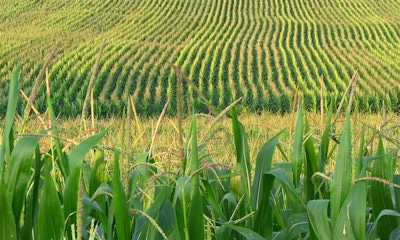March 25, 2016

Rising rainfall levels may have led to one of the most significant changes in the Earth's vegetation in the distant past, and similar climate changes today could alter the distribution of plants in the future, according to a new study.
In a report published in Science Advances, research done on mammoth and bison hair, teeth and bones along with other data looking at climate impact on species. The research concludes that a changing climate - increased rainfall and not just a rise in carbon dioxide - explains an expansion of grassland plants during the latter part of the Neogene, a geologic era that includes the present.

MORE THAN CO2: New research shows that C4 grasses like corn got a bigger boost from climate changes including higher rainfall levels, than from the rise in carbon in the atmosphere. (Photo: Oregon State University)
Jennifer Cotton, a post doctoral researcher at the University of Utah and in the College of Forestry at Oregon State University led the research. Today, she is assistant professor at the California State University, Northridge.
Scientists have long known that some grassland plants became more abundant during this period including ancestors of corn, sugar cane and sorghum. These are C4 grasses, and they use a different method of metabolism via photosynthesis that’s different from other types of vegetation called C3 grasses.
Looking at those bones, teeth and hair they sought to understand what drove the transition from C3 grasses to C4 across North America over the past 18,000 years - essentially from the peak of the last ice age to the present. Notes Cotton: "The point of the work was to understand what drove one of the most dramatic biological transitions in the past 65 million years, and also to better understand the past so that we can make predictions about the future. We know that the balance between C3 and C4 grasses is controlled by both atmospheric CO2 and climate, but the relative influence of each of these factors has not been clear."
By combining their findings with data on climate, temperature and changing carbon dioxide concentrations, the researchers showed that increasing precipitation during the growing season was the single most important factor in the spread of C4 grasses. In recent years, increases in rainfall and temperature have enabled farmers to grow corn in the upper Midwest in areas dominated by wheat.
Many have postulated that as CO2 levels rise C3 grasses could get a boost, but Cotton notes that this work suggested that climate - rainfall for example - rather than CO2 fertilization will drive future changes to C3 and C4 grass distributions, which will likely benefit C4 grasses in much of the Great Plains."
The National Science Foundation provided funding for the research. Cotton’s co-authors included Christopher J. Still and Thomas M. Mosier at Oregon State, Thure E. Cerling at the University of Utah and Kathryn A. Hoppe at the University of Washington.
You May Also Like




